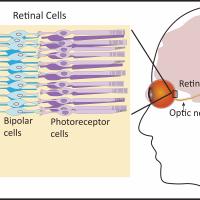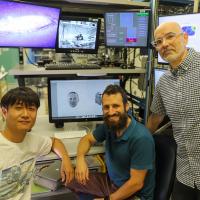About our work
Most of our knowledge about visual processing in the early visual cortex in humans comes from studies examining the central about 10degrees of the visual field. Yet, vision loss often selectively affects the peripheral visual field. For example, glaucoma, an increasingly frequent condition, which in 2022 affected 4.22 million people in the US, typically causes peripheral vision loss (“tunnel vision”). Additionally, deficits in the ability to use visual information in a context-dependent way have been implicated in psychiatric diseases such as schizophrenia and attention-deficit hyperactivity disorders. Still, current pioneering work on visual prostheses relies on static, rather than context-dependent visual processing. Understanding the role of context-dependent processing is therefore important not only for unraveling fundamental mechanisms of cognition and perception but also for addressing their dysfunction in disorders of vision and cognition.
The Visual Decision Making Section takes a comprehensive view to address how vision supports action: it combines the study of processing for the peripheral visual field, visually guided decision-making in diverse behavioral contexts, and adult neural plasticity in the visual system. To do so we combine computational, behavioral, pharmacological, functional imaging, videography and large-scale electrophysiological approaches in mammals, and, through collaboration, machine-learning techniques. We also collaborate with researchers across other institutes of the NIH, including at the National Institute of Mental Health (NIMH), and outside of the NIH. The insights gained on visual processing of the peripheral visual field and how this processing may differ from that of the parafoveal central visual field, may provide guidance to address deficits in peripheral vision loss, as resulting, e.g., from glaucoma. Knowledge about how behavioral context and eye movements dynamically modify visual processing promises to provide insights valuable for designing visual prostheses that rely on static processing. Finally, identifying neural substrates of the pronounced naturally occurring plasticity during hibernation may uncover new approaches to treat conditions that require neural plasticity, such as rehabilitation after stroke, neurodegeneration or dementia.
Selected publications
Talluri*, Kang*, Lazere, Quinn, Kaliss, Yates, Butts, Nienborg: Activity in primate visual cortex is minimally driven by spontaneous movements. Nat Neurosci 26:1953–1959 (2023)(https://www.nature.com/articles/s41593-023-01459-5) *: equal contribution
Quinn, Seillier, Butts, Nienborg, Decision-related feedback in visual cortex lacks spatial selectivity Nat Commun (2021) 12: 4473 https://www.nature.com/articles/s41467-021-24629-0
Nienborg, Meyer Neuroscience needs behavior: inferring psychophysical strategy trial by-trial. Neuron (2021) 109:561-563 https://doi.org/10.1016/j.neuron.2021.01.025
Macke, Nienborg Choice (-history) correlations in sensory cortex: cause or consequence? Current Opin Neurobiol (2019) 58:148-154. https://doi.org/10.1016/j.conb.2019.09.005
Kawaguchi, Clery, Seillier, Pourriahi, Haefner, Nienborg: Differentiating between Models of Perceptual Decision Making Using Pupil Size Inferred Confidence J Neurosci (2018) 38:8874-8888. https://doi.org/10.1523/JNEUROSCI.0735-18.2018
Jacob, Nienborg: Monoaminergic neuromodulation of sensory processing Front Neural Circuits (2018) https://doi.org/10.3389/fncir.2018.00051
Lueckmann, Macke*, Nienborg*: Can serial dependencies in choices and neural activity explain choice probability? J Neurosci , (2018) 38:3495-3506. https://doi.org/10.1523/JNEUROSCI.2225-17.2018
Seillier*, Lorenz*, Kawaguchi, Ott, Nieder, Pourriahi, Nienborg: Serotonin decreases the gain of visual responses in awake macaque V1 J Neurosci , (2017): 37:11390-11405 (* equal contribution) https://doi.org/10.1523/JNEUROSCI.1339-17.2017
Clery, Cumming, Nienborg: Decision-Related Activity in Macaque V2 for Fine Disparity Discrimination Is Not Compatible with Optimal Linear Readout. J Neurosci , (2017) : 37:715-725 https://doi.org/10.1523/JNEUROSCI.2445-16.2016
Nienborg, Roelfsema: Belief states as a framework to explain extra-retinal influences in visual cortex. Current Opin Neurobiol, (2015): 32: 45-52. https://doi.org/10.1016/j.conb.2014.10.013
Nienborg, Cumming: Decision-related activity in sensory neurons reflects more than a neuron’s causal effect. Nature, (2009): 459:89-92. https://www.nature.com/articles/nature07821
Visual Decision Making Section key staff
| Name | Title | Phone | |
|---|---|---|---|
| Laura Castillo | Graduate Student | laura.castillo@nih.gov | |
| Allison Fultz | Postbaccalaureate IRTA | allison.fultz@nih.gov | |
| Incheol Kang, Ph.D. | Research Fellow | incheol.kang@nih.gov | 301-594-4564 |
| Hendrikje Nienborg, M.D., Ph.D. | Senior Investigator | hendrikje.nienborg@nih.gov | 301-496-3549 |
| Bharath Chandra Talluri, Ph.D. | Postdoctoral Fellow | bharath.talluri@nih.gov | 301-496-9376 |
| Sriram Thothathri | Postbaccalaureate IRTA | sriram.thothathri@nih.gov | |
| Wojciech Zajkowski, Ph.D. | Postdoctoral Fellow | wojciech.zajkowski@nih.gov | |
| Corey Ziemba, Ph.D. | Staff Scientist | corey.ziemba@nih.gov | 301-443-7479 |
Visual Decision Making Section alumni
| Name | Title | Time Period |
|---|---|---|
| Christina Jacob, B.S. | Postbaccalaureate IRTA | |
| Leya Luo, B.S. | Postbaccalaureate IRTA | |
| Colin Mason, B.S. | Postbaccalaureate IRTA | |
| Adam Lazere | Postbaccalaureate IRTA | |
| Emily Meyer | Postbaccalaureate IRTA | |
| Katrina Quinn | Graduate Student |



